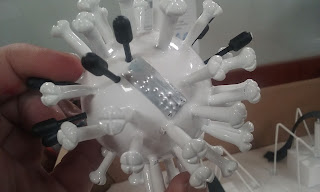 |
| Disponemos de un kit con todos los modelos empaquetados |
 |
| En esta fotografía se ve la diferencia de tamaños entre célula eucariota, bacteria y virus |
Nuestra idea es que las personas puedan tocar los tres tipos básicos de microorganismos y "sentir" la diferencia de tamaño. En este sentido, nuestros kits didácticos son ideales para enseñar microbiología a invidentes.
Bibliografía:
Caldwell, J. E., and Teagarden, K. (2007). "Adapting Laboratory Curricula for Visually Impaired Students." Proceedings of the 28th Workshop/Conference of the Association for Biology Laboratory Education (ABLE), 28, 357-361.
Moon, N. W., Todd, R. L., Morton, D. L., and Ivey, E. (2012). "Accommodating Students with Disabilities in Science, Technology, Engineering, and Mathematics (STEM): Findings from Research and Practice for Middle Grades through University Education." Atlanta, GA: SciTrain: Science and Math for All, sponsored by the National Science Foundation under Award No. 0622885.
Supalo, C. A. (2010). "Teaching Chemistry and Other Sciences to Blind and Low-vision Students through Hands-on Learning Experiences in High School Science Laboratories." (Doctoral dissertation). Retrieved from ProQuest Dissertations and Theses. (3442959)
Vollmer, A. C. (2012, July 26). "Seeing Biology through the Eyes of Visually Impaired Students." Odds and Ends, Teachers Corner: Pedagogical Issues. American Society for Microbiology. Retrieved 11/14/2014 from <http://schaechter.asmblog.org/schaechter/2012/07/seeing-biology-through-the-eyes-of-visually-impaired-students.html>
Womble, M. D. and Walker, G. R. (2001). "Teaching Biology to the Visually Impaired: Accommodating Students' Special Needs." Journal of College Science Teaching, 30 (6), 394-396.


No hay comentarios:
Publicar un comentario
Cada vez que lees un artículo y no dejas un comentario, alguien mata a un gatito en alguna parte del mundo...